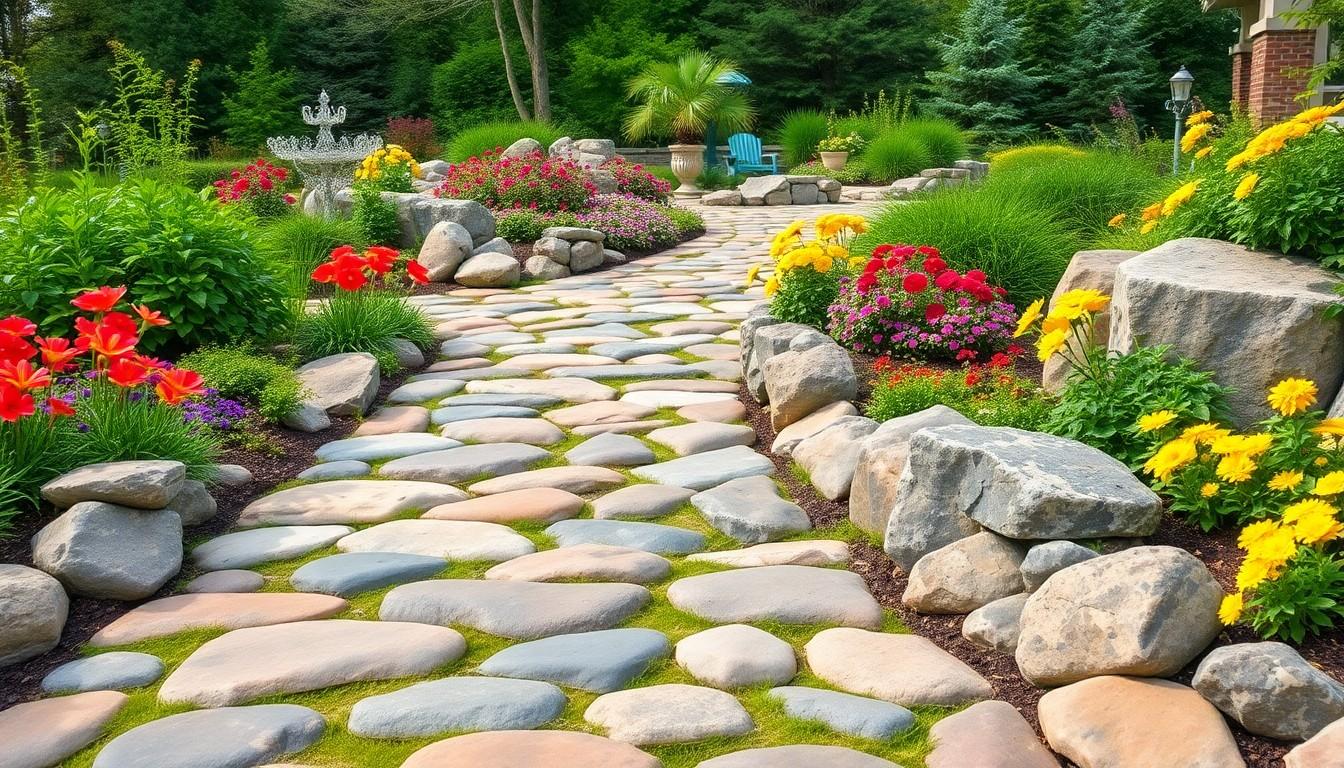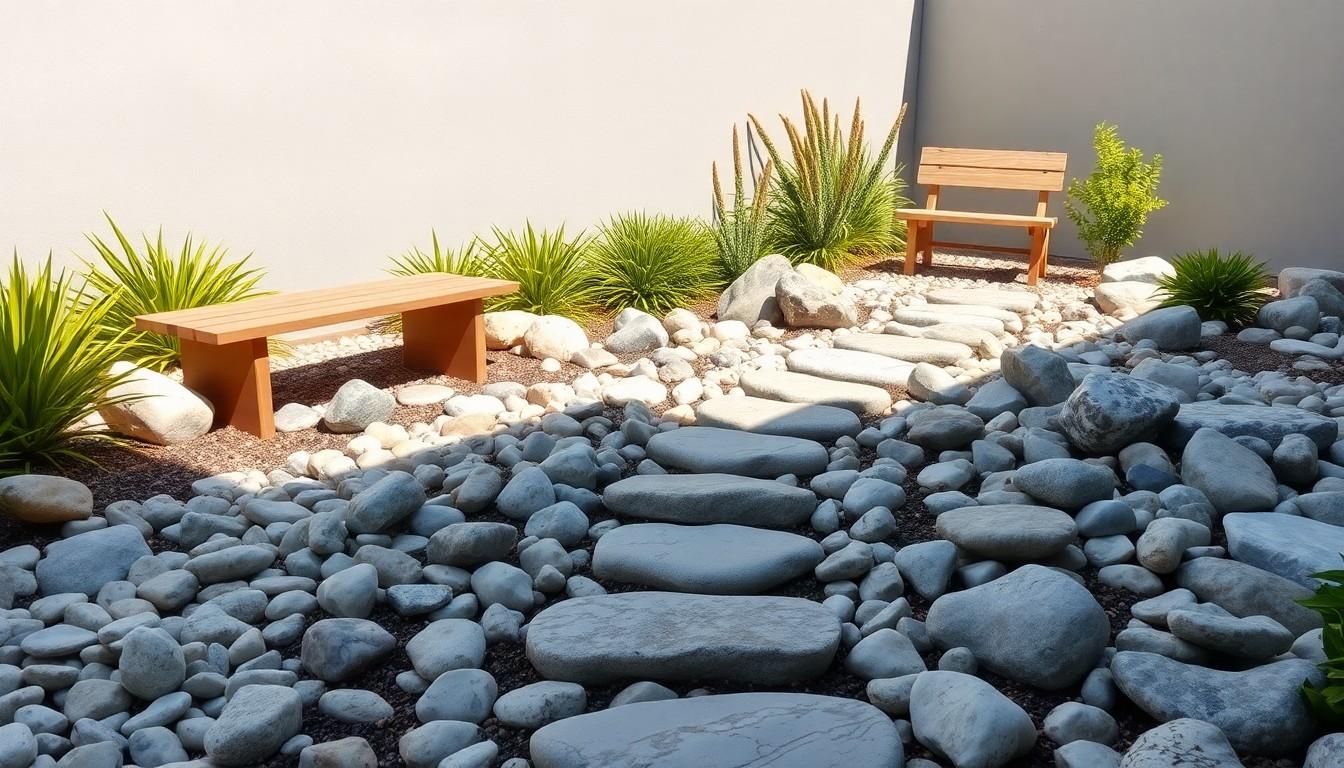Landscaping with river rock isn’t just about tossing a few stones around and calling it a day. It’s a chance to transform outdoor spaces into stunning masterpieces that even Mother Nature would envy. Whether you’re aiming for a Zen garden vibe or just want to avoid mowing that pesky patch of grass, river rock offers a versatile solution that’s as practical as it is beautiful.
Landscaping River Rock
Landscaping with river rock creates visually appealing and functional outdoor spaces. This type of rock, smooth and often found in various colors, offers design versatility. Gardeners and landscapers utilize river rock in pathways, flower beds, and even decorative features.
Color choices include white, gray, and brown, providing options for different aesthetics. Applications extend to drainage solutions, where river rock helps manage water flow effectively. Gardeners appreciate its ability to suppress weeds while enhancing landscape beauty.
River rock complements various styles, including modern, rustic, and Mediterranean landscapes. Incorporating it in a Zen garden encourages tranquility, while featuring it in a contemporary design adds sophistication. Professionals often suggest layering river rock of varying sizes to create depth and interest in a landscape.
Maintenance requirements are minimal compared to traditional lawns. Providing a consistent appearance year-round, river rock remains an attractive choice across seasons. For those seeking an eco-friendly option, river rock reduces water consumption and chemical usage typically associated with lawn care.
Budget considerations play a role in selecting river rock. Costs vary based on size and color, with averages ranging from $50 to $150 per ton. Factoring installation brings additional expenses but often leads to lower long-term maintenance costs, making it a practical investment for homeowners.
Choosing river rock in landscaping promotes both aesthetic appeal and functionality, enhancing outdoor environments effectively.
Benefits of Landscaping River Rock

Landscaping with river rock offers numerous advantages that enhance outdoor spaces. It transforms gardens into beautiful, functional areas while minimizing upkeep.
Aesthetic Appeal
Visual charm characterizes river rock landscapes. Various colors like white, gray, and brown provide flexibility in design choices. Smooth textures create a relaxed atmosphere that suits many styles, including modern and rustic. Layering different-sized stones adds depth, making the landscape more inviting and interesting. River rock pathways lead to flower beds and other focal points, guiding visitors through the garden elegantly. The natural look blends seamlessly with surrounding environments, creating a cohesive outdoor aesthetic.
Durability and Longevity
Durability defines river rock as a landscaping material. Stones withstand harsh weather conditions, ensuring longevity without deteriorating. Unlike traditional lawns, river rock does not require constant maintenance, reducing both time and effort. It resists fading and retains a consistent appearance throughout the seasons. Effective drainage capabilities prevent water accumulation, further enhancing stability. River rock also acts as a natural weed barrier, reducing growth and preserving the desired landscape look over time. Homeowners enjoy lasting beauty and functionality with minimal intervention needed.
Types of Landscaping River Rock
Landscaping river rock includes various types, each serving unique purposes. Understanding these variations aids in selecting the right option for specific projects.
Small vs. Large River Rocks
Small river rocks, typically ranging from 1 to 2 inches in diameter, create a delicate appearance. They work well in flower beds and as ground cover due to their ability to fit neatly around plants. Large river rocks, on the other hand, measure over 2 inches and provide an impressive visual impact. These larger stones act as focal points in a garden design, often used for borders or rock gardens. Each size contributes differently to overall aesthetics, thus enhancing the landscape’s appeal.
Color Variations
Color variations in river rock significantly influence landscaping choices. Common colors include white, gray, brown, and even multi-colored options. Rich brown stones blend seamlessly with earthy tones, perfect for rustic designs. Gray rocks, often smooth and polished, suit modern aesthetics. White river rock adds brightness and contrasts beautifully with vibrant plants. Choosing the right color enhances the theme of the garden, creating a cohesive design that draws the eye.
Installation Techniques for Landscaping River Rock
Landscaping with river rock requires strategic installation techniques for lasting beauty. Following the right steps ensures optimal results.
Preparing the Area
Clearing the area of debris becomes essential before installation. Removing existing grass and weeds prevents unwanted growth. Leveling the soil ensures an even surface, promoting proper drainage. Next, consider laying landscaping fabric to reduce weed emergence while allowing water to flow through. It enhances longevity and simplifies future maintenance.
Placement and Layout
Choosing a focal point guides the placement of stones effectively. Arranging river rocks in a desired pattern creates visual interest. Grouping similar sizes enhances cohesion across the landscape. Spreading larger stones in key areas adds dimension while smaller stones fill gaps. Consider using edging materials to define boundaries, creating a polished look. Lastly, ensure proper spacing to allow for natural drainage and airflow, avoiding potential issues.
Maintenance Tips for Landscaping River Rock
Maintaining river rock landscapes requires specific care to keep them looking pristine. Regular attention to weeds and cleaning ensures the aesthetic quality remains high.
Weeding and Cleaning
Weeds can undermine the visual appeal of river rock landscapes. Hand-pulling or using a hoe keeps unwanted plants in check. Applying mulch in areas where river rock isn’t present reduces weed growth. Cleaning also plays a vital role. A simple rinse with a garden hose can remove dust and organic debris. Using a soft brush for stubborn stains helps preserve the rock’s appearance.
Seasonal Considerations
Weather changes affect river rock maintenance. In spring, inspect for winter debris and promptly clear it away. Summer may require extra attention due to heat, so checking for weeds is essential. Autumn brings falling leaves, which should be removed to prevent mold. Winter’s snow and ice might compact the stones; regular shoveling maintains the landscape’s integrity. A proactive approach in every season enhances the longevity and beauty of river rock features.
The Durability Of River Rock
Landscaping with river rock offers a unique blend of beauty and practicality that transforms outdoor spaces. Its versatility allows homeowners to create stunning designs while minimizing maintenance efforts. The durability of river rock ensures it withstands the test of time, making it a smart investment for any landscape.
By selecting the right sizes and colors, individuals can achieve a cohesive look that enhances their property’s aesthetic. With proper installation and maintenance, river rock landscapes provide lasting charm and functionality. Embracing river rock not only elevates the visual appeal of gardens but also contributes to an eco-friendly approach to landscaping.




